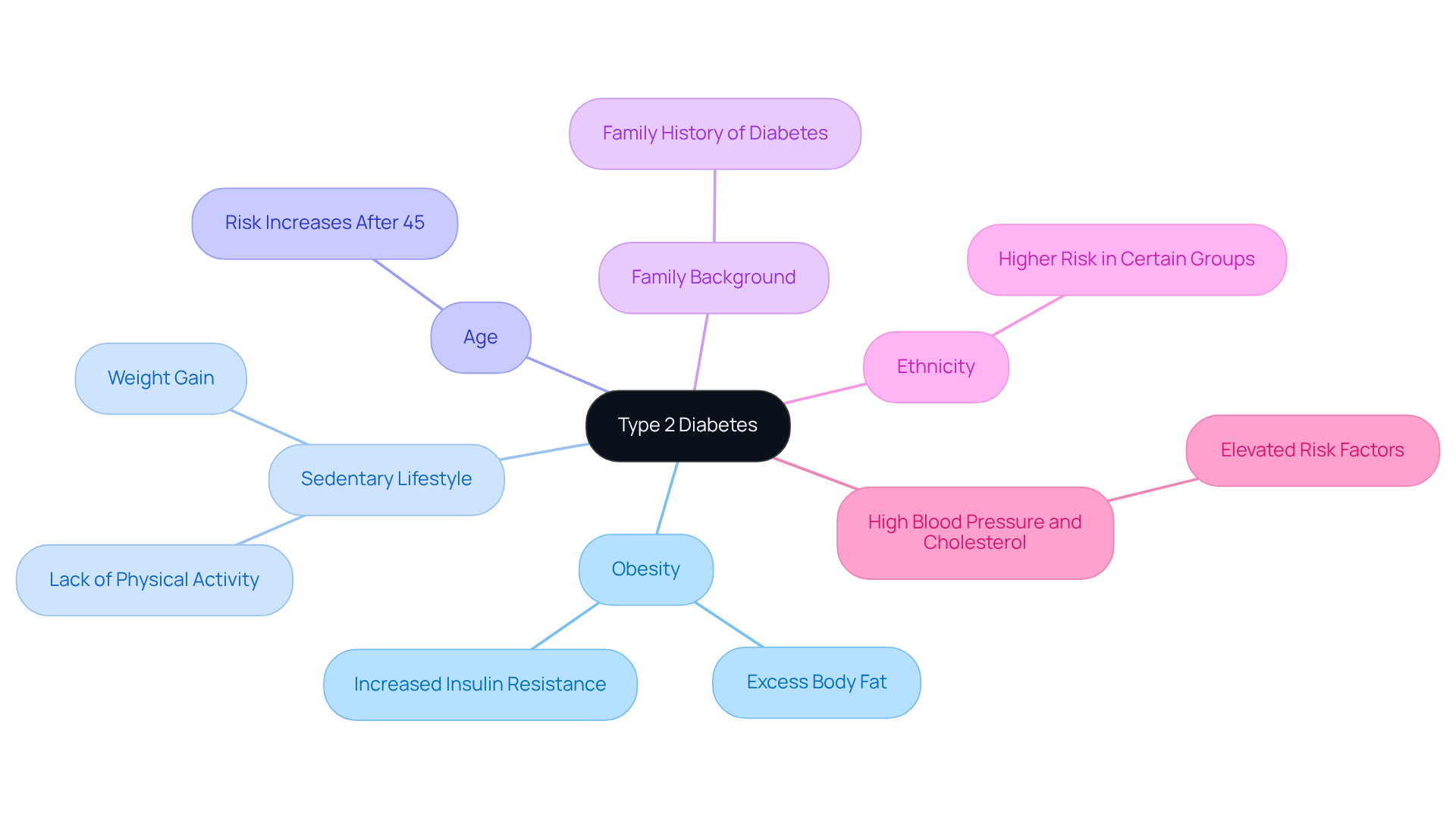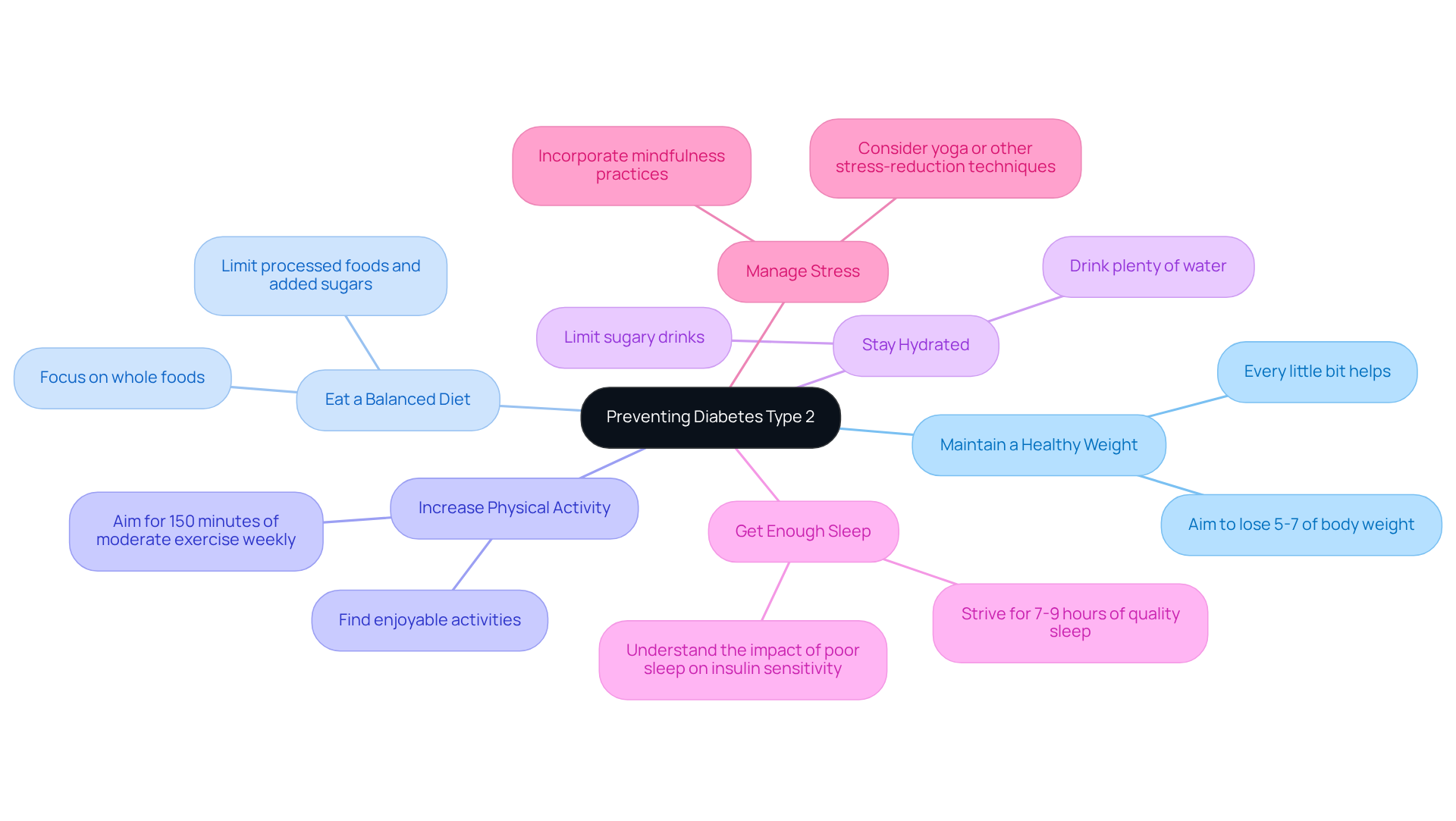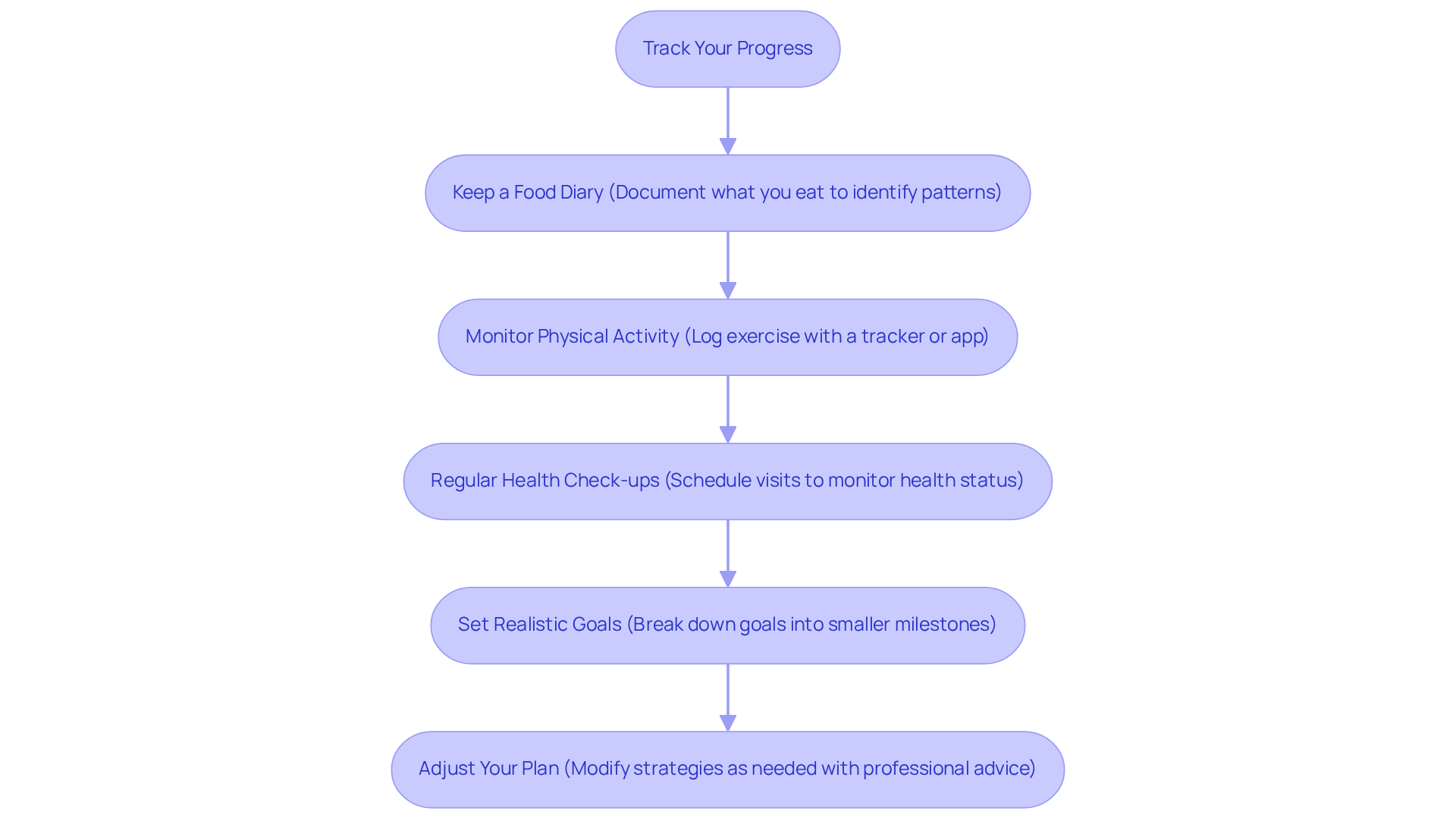Overview
To prevent Type 2 diabetes, it’s important to focus on maintaining a healthy weight and embracing a balanced diet. Increasing physical activity, staying hydrated, ensuring adequate sleep, and managing stress are also crucial steps. It’s understandable to feel overwhelmed by these changes, but know that you are not alone in this journey.
This article outlines specific lifestyle changes and tracking methods that can significantly reduce risk factors associated with the condition. By taking proactive steps and seeking support, you can navigate this path with confidence. Remember, we are here to support you every step of the way.
Consider these changes as part of a nurturing journey toward better health. Each small step you take can lead to significant improvements in your well-being. You have the power to make a difference in your life.
Introduction
Understanding the risk factors and lifestyle choices that contribute to Type 2 Diabetes is essential for anyone aiming to maintain their health. It's concerning to see rising obesity rates and sedentary lifestyles, making the urgency to prevent this chronic condition more critical than ever. This article serves as a roadmap for individuals seeking actionable steps to reduce their risk. From adopting healthier eating habits to incorporating regular exercise, there are many paths to consider.
But what happens when well-intentioned efforts fall short? It's understandable to feel overwhelmed at times. How can one ensure sustained progress in the fight against this prevalent disease? Remember, you're not alone in this journey. We are here to support you every step of the way, guiding you toward the resources and encouragement you need.
Understand Type 2 Diabetes and Its Risk Factors
Type 2 Diabetes is a chronic condition that affects how your body metabolizes sugar (glucose). It occurs when your body becomes resistant to a hormone that regulates blood sugar or when the pancreas doesn't produce enough of that hormone. Understanding the risk factors is crucial for knowing how to prevent diabetes type 2, and it's important to know that you’re not alone in this journey. Here are some common risk factors to consider:
- Obesity: Carrying excess body fat, especially around the abdomen, can increase insulin resistance.
- Sedentary Lifestyle: Not getting enough physical activity can lead to weight gain and further insulin resistance.
- Age: The risk increases as you get older, particularly after age 45.
- Family Background: A family history of diabetes can raise your likelihood of developing the condition.
- Ethnicity: Certain ethnic groups, such as African Americans, Hispanic Americans, and Native Americans, may be more susceptible.
- High Blood Pressure and Cholesterol: These conditions can also elevate your risk of developing diabetes.
By recognizing these factors, you can take proactive steps on how to prevent diabetes type 2 while making informed lifestyle choices. Remember, it’s understandable to feel overwhelmed, but you have the power to make positive changes.
At T2DSolutions, we are dedicated to offering extensive resources and community support for individuals managing Type 2 Diabetes. We invite you to subscribe to our updates so you can stay informed about new content and strategies that can help you lead a healthier life. Together, we can navigate this journey and find the support you need.

Implement Healthy Lifestyle Changes
To effectively learn how to prevent diabetes type 2, consider making some supportive lifestyle changes that can significantly impact your health.
-
Maintain a Healthy Weight: If you find yourself overweight, aiming to lose just 5-7% of your body weight can make a big difference in lowering your chances of developing diabetes. Every little bit helps, and you’re not alone in this journey.
-
Eat a Balanced Diet: Focus on nourishing your body with whole foods like fruits, vegetables, whole grains, and lean proteins. It’s also wise to limit processed foods, added sugars, and saturated fats. Remember, you deserve to feel your best.
-
Increase Physical Activity: Aim for at least 150 minutes of moderate-intensity exercise each week. Whether it’s walking, cycling, swimming, or any form of aerobic exercise, finding an activity you enjoy can make it easier to stay active.
-
Stay Hydrated: Drinking plenty of water and limiting sugary drinks is essential. Staying hydrated not only supports your overall health but can also aid in managing your weight.
-
Get Enough Sleep: Strive for 7-9 hours of quality sleep each night. It’s understandable to feel that life can get in the way, but poor sleep can affect your insulin sensitivity and increase the likelihood of diabetes.
-
Manage Stress: Chronic stress can lead to unhealthy eating habits and weight gain. Consider incorporating mindfulness practices, yoga, or other stress-reduction techniques into your routine. Remember, taking care of your mental health is just as important as your physical health.
By integrating these adjustments into your everyday habits, you can learn how to prevent diabetes type 2 and significantly reduce your chances of developing it. You're not alone in this journey; we are here to support you every step of the way.

Track Your Progress and Adjust Your Plan
To ensure that your prevention efforts are effective, it’s important to track your progress. You’re not alone in this journey, and we’re here to support you every step of the way.
- Keep a Food Diary: Documenting what you eat can help you identify patterns and areas for improvement. This practice not only keeps you accountable but also empowers you to make healthier choices.
- Monitor Physical Activity: Using a fitness tracker or app to log your exercise can be beneficial. Aim to meet your weekly activity goals, and remember, it’s okay to adjust as necessary. It’s understandable to feel overwhelmed, but every step counts.
- Regular Health Check-ups: Scheduling regular visits with your healthcare provider is essential. Monitoring your blood sugar levels, blood pressure, and cholesterol will help you stay informed about your health status, providing peace of mind.
- Set Realistic Goals: Breaking down your overall goals into smaller, achievable milestones can make a significant difference. Celebrate your successes, no matter how small, to keep your motivation alive.
- Adjust Your Plan: If you find that certain strategies aren’t working, don’t hesitate to modify your approach. Consulting with a healthcare professional or a certified diabetes educator can provide you with personalized advice tailored to your needs.
By actively tracking your progress and being willing to adjust your plan, you can maintain your commitment to how to prevent diabetes type 2. Remember, you’re not alone in this journey, and there are resources available to support you.

Conclusion
Understanding how to prevent Type 2 Diabetes is essential for maintaining long-term health and well-being. By recognizing risk factors such as obesity, a sedentary lifestyle, and family history, you can take proactive steps toward prevention. Embracing healthier habits can significantly lower your risk of developing this chronic condition, and we are here to support you every step of the way.
Key strategies to consider include:
- Maintaining a healthy weight
- Eating a balanced diet
- Increasing physical activity
- Staying hydrated
- Ensuring adequate sleep
- Managing stress
These lifestyle changes not only contribute to diabetes prevention but also enhance your overall health. It’s also important to track your progress through food diaries, fitness logs, and regular health check-ups, as this helps keep you accountable and motivated throughout your journey.
Ultimately, the message is clear: taking control of your health is a shared journey, and every small change counts. By committing to these essential steps and seeking support when needed, you can effectively reduce your risk of Type 2 Diabetes. Remember, the path to better health is within reach, and now is the perfect time to take action and prioritize preventive measures for a healthier future. You're not alone in this journey; together, we can make a difference.
Frequently Asked Questions
What is Type 2 Diabetes?
Type 2 Diabetes is a chronic condition that affects how the body metabolizes sugar (glucose), occurring when the body becomes resistant to insulin or when the pancreas does not produce enough insulin.
What are the common risk factors for developing Type 2 Diabetes?
Common risk factors include obesity, a sedentary lifestyle, age (particularly over 45), family history of diabetes, certain ethnic backgrounds (such as African Americans, Hispanic Americans, and Native Americans), and high blood pressure and cholesterol.
How does obesity contribute to the risk of Type 2 Diabetes?
Carrying excess body fat, especially around the abdomen, can increase insulin resistance, which is a significant factor in the development of Type 2 Diabetes.
Why is a sedentary lifestyle a risk factor for Type 2 Diabetes?
Not getting enough physical activity can lead to weight gain and further increase insulin resistance, raising the risk of developing Type 2 Diabetes.
How does age affect the risk of developing Type 2 Diabetes?
The risk of developing Type 2 Diabetes increases with age, particularly after the age of 45.
What role does family history play in the risk of Type 2 Diabetes?
Having a family history of diabetes can raise an individual's likelihood of developing Type 2 Diabetes.
Which ethnic groups are more susceptible to Type 2 Diabetes?
Certain ethnic groups, including African Americans, Hispanic Americans, and Native Americans, may have a higher susceptibility to Type 2 Diabetes.
How do high blood pressure and cholesterol relate to Type 2 Diabetes?
High blood pressure and cholesterol can elevate the risk of developing Type 2 Diabetes, as they are often associated with insulin resistance and other metabolic issues.
What steps can individuals take to prevent Type 2 Diabetes?
Recognizing risk factors allows individuals to take proactive steps, such as making informed lifestyle choices, to prevent Type 2 Diabetes.
How can T2DSolutions assist individuals managing Type 2 Diabetes?
T2DSolutions offers extensive resources and community support for individuals managing Type 2 Diabetes, including updates on new content and strategies for leading a healthier life.



